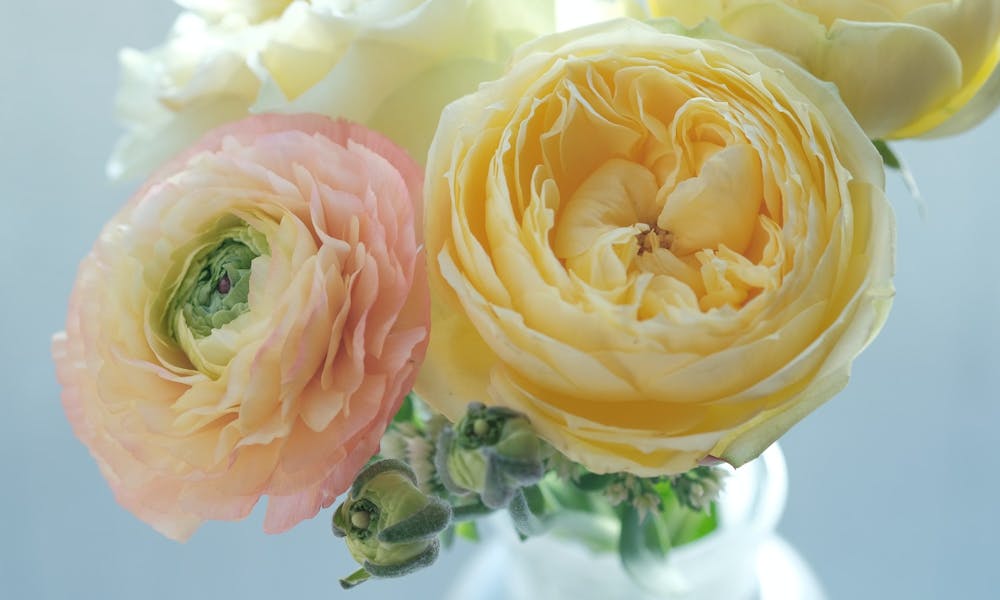Welcome to our comprehensive guide on ranunculus, the enchanting flowers that captivate hearts with their vibrant colors and delicate petals. In this article, we will dive into the world of ranunculus, exploring their origins, characteristics, care tips, and much more. Whether you’re a gardening enthusiast, a florist, or simply someone who appreciates the beauty of nature, this guide is for you. Let’s embark on this floral journey and unravel the secrets of ranunculus!
Ranunculus: A Closer Look
Ranunculus, also known as buttercups, belong to the genus Ranunculus, which is part of the Ranunculaceae family. These stunning flowers come in a variety of colors, including vibrant shades of red, pink, orange, yellow, and white. Ranunculus flowers feature multiple layers of delicate petals that create a full and lush appearance. They are commonly used in floral arrangements, weddings, and other special occasions due to their captivating beauty.
The Origins of Ranunculus
Ranunculus originated in Asia, Europe, and North America, and they have a rich history dating back centuries. These flowers have been admired for their beauty since ancient times, and they hold symbolic meanings in different cultures. In the Victorian era, ranunculus were highly cherished and often given as gifts to express affection and admiration.
The Growing Popularity of Ranunculus
In recent years, the popularity of ranunculus has surged, with many people falling in love with their charm and elegance. Florists and gardeners alike have recognized the unique qualities of these flowers, incorporating them into their creations and landscapes. The demand for ranunculus has increased, leading to a wide variety of cultivars and hybrids available to suit every preference.
Ranunculus in Gardens and Landscapes
Creating a Ranunculus Garden
If you’re considering adding ranunculus to your garden, you’re in for a treat. These flowers can bring vibrancy and elegance to any landscape. To create a stunning ranunculus garden, follow these steps:
- Selecting the Right Location: Choose a sunny spot in your garden that receives at least six hours of direct sunlight per day.
- Preparing the Soil: Ranunculus thrive in well-draining soil. Prepare the soil by adding organic matter such as compost to improve its texture and fertility.
- Planting Ranunculus Bulbs: Plant the ranunculus bulbs in the prepared soil, ensuring they are spaced adequately to allow for growth and airflow.
- Watering and Care: Ranunculus prefer moist soil, so water them regularly but avoid overwatering. Mulching can help retain moisture and control weeds.
- Fertilizing: Apply a balanced, slow-release fertilizer to nourish the ranunculus plants throughout the growing season.
- Pest and Disease Management: Monitor your ranunculus plants for pests and diseases, taking appropriate measures to control them if necessary.
Ranunculus as Cut Flowers
Ranunculus make exceptional cut flowers due to their long stems and vibrant colors. Here are some tips to ensure your ranunculus bouquets last longer:
- Harvesting: Cut the ranunculus stems early in the morning when the flowers are fully hydrated.
- Preparing the Stems: Remove any leaves that will be submerged in water to prevent bacterial growth. Cut the stems at an angle to enhance water absorption.
- Water and Food: Place the ranunculus stems in a clean vase filled with fresh water mixed with floral preservative. Change the water every few days and trim the stems periodically.
- Display and Maintenance: Keep the ranunculus bouquet away from direct sunlight and drafts. Remove any wilted flowers to promote longevity.
Frequently Asked Questions (FAQs)
- Q: How long do ranunculus flowers bloom? A: Ranunculus flowers typically bloom for about two to three weeks, depending on the variety and growing conditions.
- Q: Can ranunculus grow in pots? A: Yes, ranunculus can be grown in pots. Choose a container with good drainage and follow the same planting and care instructions as for garden-grown ranunculus.
- Q: Are ranunculus flowers fragrant? A: While some ranunculus varieties have a mild fragrance, most are not strongly scented.
- Q: Can I store ranunculus bulbs for the next season? A: Yes, you can store ranunculus bulbs for future planting. After the foliage dies back, carefully dig up the bulbs, remove any excess soil, and store them in a cool, dry place until the next planting season.
- Q: Are ranunculus flowers toxic to pets? A: Yes, ranunculus flowers contain compounds that can be toxic to pets if ingested. Keep them out of reach of curious animals.
- Q: Can ranunculus be grown from seeds? A: Ranunculus are typically grown from bulbs rather than seeds, as bulbs produce more reliable and consistent results.
Conclusion
Ranunculus, with their enchanting beauty and captivating colors, have charmed people for centuries. From gardens to bouquets, these flowers add a touch of elegance and vibrancy to any setting. Whether you’re a gardening enthusiast or someone who appreciates floral aesthetics, exploring the world of ranunculus is a delightful journey. We hope this guide has provided valuable insights into the origins, care tips, and uses of ranunculus. Embrace the allure of these stunning flowers and let them bring joy and beauty into your life.
